

Phoenixes, Mulberries, Whales, Lobnitzes, Corncobs and Role of Tugs at Normandy Harbor on D-Day June 6, 1944
Success of an amphibious landing depends not only on the initial assault, but on being able to supply and reinforce the invading troops. Preparations for the allied invasion of Normandy -- Operation Overlord -- began in August of 1943.
 |
 |
| Lee-on-Solent and the English Channel | Mulberries at Omaha and Gold Beach |
Shipyards around Great Britain employed 20,000 workers around the clock to build 150 concrete structures 200 feet long by 60 feet wide, by 60 feet high. These hollow blocks, called Phoenixes, were to be laid end to end to form two giant breakwaters -- one at the British beach, one at the American.
Perry Adams of San Carlos, California [at left, March 1944], arrived at the former summer resort, Lee-on-Solent, just across from the Isle of Wight, in March of 1944. Adams was a Purser/Pharmacist's Mate on the tug, MV Farallon, which carried a crew of 32 mariners plus 11 Naval Armed Guard.
The MV Farallon was one of 10 War Shipping Administration tugs operated by Moran Towing of New York, in company with 2 U.S. Navy tugs, 2 Dutch tugs, and several British tugs. The MV Farallon was 195 feet long, 37 feet wide, draft 15.5 feet, displacement 1,063 tons, 2,250 horsepower and could do 14 knots in light conditions. photo of V-4 Tug
The tugs first assignment was to tow the completed Phoenixes from shipyards throughout Great Britain and to anchor them in the inlet near Lee-on-Solent.
 |
| Phoenixes at anchor near Lee-on-Solent |
On June 4th or 5th, 1944 the tugs began towing the Phoenixes at 3 or 4 knots towards Normandy -- a distance of about 90 miles. The tugs stalled for a while when the invasion was postponed for a day, and on June 6 anchored next to a battleship about 4 or 5 miles offshore. The battleship shelled the beaches all day and night.
 |
| MV
Farallon towing a Phoenix on June 7, 1944 Normandy is barely visible in the background |
On June 7, about a mile offshore, the MV Farallon and other large tugs turned the Phoenixes over to small harbor tugs operated by "civilian" mariners of the Army Transport Service, who held them in position while sea valves were opened to flood the interior. The MV Farallon made 8 or 9 round trips towing Phoenixes from England.
 |
| Small Harbor Tugs positioning a Phoenix at Normandy |
When completed, each Mulberry was about one mile long, and stood about 30 feet above sea level at low tide, 10 feet above sea level at high tide. Seven Liberty ships at a time could tie up at a Mulberry to unload their cargo into landing craft.
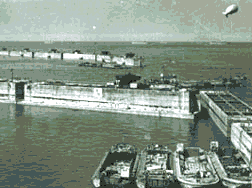 |
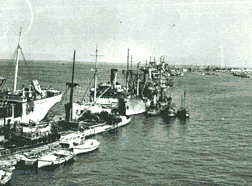 |
| 75 Phoenixes formed a Mulberry. Each Phoenix was topped with an anti-aircraft gun emplacement. Note the barrage balloon for protection against dive bombers | Derelict ships were sunk to form a Gooseberry |
Extending the artificial harbor were 89 derelict ships which had been damaged beyond repair. These ships made it to Normandy under their own power, crewed by volunteer mariners. Each was held in position by 4 small tugs while explosives blew their bottoms out, sinking them to create a Gooseberry or blockships. The tugs removed the crew from the ships. These breakwaters calmed the waters inside the harbor and eliminated the surf and breakers on the beach.
This was done under fire from the beach and German planes.
Lobnitz Pierheads were giant upside-down tables 60 feet wide and 200 feet long -- with 4 huge steel legs. The legs were dropped down into the sand, and the "tabletop" adjusted to the water level. Seven Lobnitzes side-by-side created a 1,400 foot-long pier which allowed LST's and cargo ships to unload directly into trucks. During her trip from New York to England in March 1944, the MV Farallon towed a barge which was destined to become the floating "tabletop" of a Lobnitz.
Whale causeways -- steel pontoon bridges which connected the Lobnitz Pierheads to the shore -- were towed from England on barges. Bombardons, seen as a straight line just below the words Omaha Beach on the map, were narrow steel floats 200 feet long which were moored outside the Mulberries to help break up the incoming waves.
|
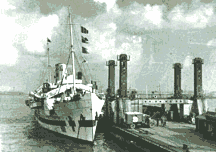
|
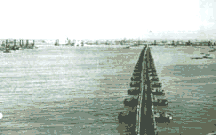 |
| Hospital ship docked at a Lobnitz Pierhead | Pontoon bridge or "Whale" causeway |
Operation Corncob was the name given to getting the harbor to Normandy and assembling it in position. The idea for an artificial harbor such as this was first suggested by Winston Churchill during World War I. Lt. General Sir Frederick Morgan, a descendant of the pirate Henry Morgan, was in charge of planning the harbors. A similar harbor was under consideration for the invasion of Japan. The harbor at Omaha Beach was destroyed and that at Gold Beach was damaged by a storm during June 19-22, but the Allies were able to utilize the harbor at Cherbourg after June 26. In 1994 Perry Adams returned to Normandy and saw several Phoenixes remaining at Gold Beach.
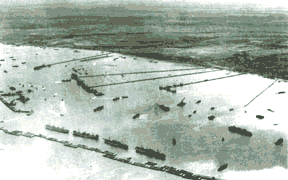 |
| Aerial view of Normandy harbor. Phoenixes at the bottom with 4 ships at anchor. Lobnitz Pierheads with a pair of Whale causeways in the center. |
Bronze Star Citation to Captain W.J. Publicover For meritorious service and courageous devotion to duty during the landing operations in Normandy, France, in June 1944.
Captain Publicover, Master of the U. S. War Shipping Administration Tug Farallon, was assigned to the task of towing vital military and naval equipment to the assault areas on the coast of France. By expert seamanship and navigational skill, and in spite of cross winds and rough seas, he accomplished his difficult task in a most efficient manner. His steadfast courage in the face of enemy artillery fire, heavily mined water, and sporadic air attack, was an inspiration to his crew. The courage and devotion to duty of Captain Publicover were in keeping with the best traditions of the United States Merchant Marine.
/s/ Harold R. Stark, Admiral, US Navy, Commander US Naval Forces in Europe, June 23, 1944
[The Captains of all 10 War Shipping Administration tugs and the 2 Navy tugs received similar Citations.]
|
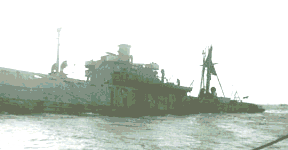
|
| The MV Farallon was towing a damaged Liberty, SS John A. Treutlen, when the Liberty was torpedoed by a German submarine. Note the tow cable in the lower right corner. |
Perry Adams entered U.S. Maritime Service basic training camp in March 1943, and continued in the Purser/Pharmacist's Mate program at Sheepshead Bay, NY.
During this 12 week program he was trained to treat wounds, administer blood plasma, dispense drugs, do minor surgery, and provide routine medical care. Six weeks at Baltimore Marine Hospital provided practical experience. Like the other 4,236 graduates of the program, Perry had an additional 6 weeks of Purser School to learn to do bookkeeping and paperwork aboard ship.
On November 1, 1943 Perry was assigned to the MV Farallon, which did rescue and tows along the Atlantic Coast until March 1944, when they left for England. They shuttled across the English Channel until December 1944. Perry Adams sailed until May 1946, returned to college, working for American Hawaiian Steam Ship Company during the summers. He sailed for a few years with Pacific Far East Lines, and remained in port positions with the shipping industry until 1976, when he started his own consulting business.
General Dwight D. Eisenhower:
Every man in this Allied command is quick to express his admiration for the loyalty, courage, and fortitude of the officers and men of the Merchant Marine. We count upon their efficiency and their utter devotion to duty as we do our own; they have never failed us yet and in all the struggles yet to come we know that they will never be deterred by any danger, hardship, or privation. When final victory is ours there is no organization that will share its credit more deservedly than the Merchant Marine.Sources:
Photographs courtesy of Perry Adams
Maps adapted from "Normandy's Made-in-England Harbors," National Geographic Magazine, May 1945 and Encarta Encyclopedia 6/5/00American Merchant Marine at Normandy June 1944
Home
Merchant Marine in WWII
Past Featureswww.USMM.org ©1998, 1999, 2000. You may quote material on this web page as long as you cite American Merchant Marine at War, www.usmm.org, as the source. You may not use more than a few lines without permission. If you see substantial portions of this page on the Internet or in published material please notify usmm.org @ comcast.net